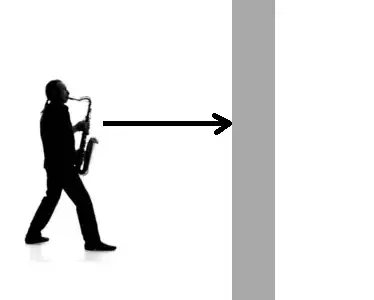Actually, the correct answer involves the concept of acoustic impedance ($Z$), the idea that different media (materials) vary in their deformation due to acoustic pressure forces.
$$ Z = \frac{acoustic \ \ pressure \ \ force}{acoustic \ \ particle \ \ velocity}$$
Acoustic waves move matter, so the material form of the system is very important when discussing impedance (or any acoustical topic, really.) So is the orientation of the object with respect to the pressure wave. Both affect the way acoustic energy travels.
This can make the actual analytical determination of frequency dependance quite complex.
Still, the music room example is relatively simple. Let's assume the wave coming from the instrument hits the (non-porous) concrete wall perpendicularly:

And you're standing on the right-hand side.
Physical properties of the wall - generally it's mass, $m$, and stiffness, $\kappa$, determine which frequencies are transmitted (to you) and which frequencies are reflected back (to the music room.)
In the following section I'm framing the idea in the same way Matthew Schwartz does here, in §5 "Complex
impedance"
. The document contains more complete derivations, too.
The total acoustic impedance is given as the sum of a resistance term, a mass term and a stiffness term:
$$Z_{total} = R + Z_m + Z_{\kappa}$$
Generally (i.e., not specific to the form of the wall), we can write an equation for acoustic impedance in terms of frequency, $f$:
$$Z_{total}(f) = R + i \ 2 \pi f m \ \ - i \frac{\kappa}{2 \pi f}$$
We see that for high-frequency components of the incident wave the mass of the wall ($m$) causes higher values of impedance at these frequencies. The same is true for stiffness ($\kappa$).
What's important is actually the difference in $m$ and $\kappa$ between the two media. We can write an acoustic transmission coefficient as a function of $f$ as well:
$$T(f) = \frac{2 \ Z_{total, \ air}(f)}{Z_{total, \ wall}(f) + Z_{total, \ air}(f)}$$
(Note that when $Z_{wall} = Z_{air}$, $T = 1$ and all incident energy at that frequency transmitted. Much more likely is the case where $Z_{air} \ll Z_{wall}$, where we expect $T$ to become quite small.)
In this example, concrete is much more massive ($+ \Delta m$) and stiff ($+ \Delta \kappa$) than air and so it lets less high frequency energy through due to both factors. However, you can imagine a situation where two adjacent media have opposing changes in each property, for example ice and water. Ice is less massive (dense) than water ($- \Delta m$), but also much stiffer ($+ \Delta \kappa$). In such a case we might expect a central frequency to be the most effectively transmitted.
